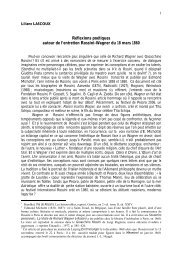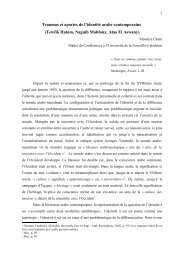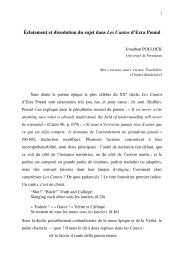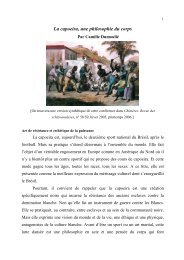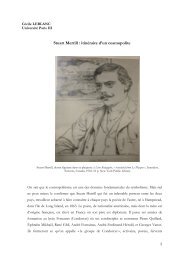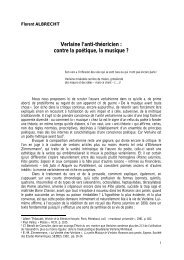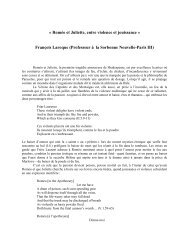CAPOEIRA, A PHILOSOPHY OF THE BODY
CAPOEIRA, A PHILOSOPHY OF THE BODY
CAPOEIRA, A PHILOSOPHY OF THE BODY
Create successful ePaper yourself
Turn your PDF publications into a flip-book with our unique Google optimized e-Paper software.
<strong>CAPOEIRA</strong>, A <strong>PHILOSOPHY</strong> <strong>OF</strong> <strong>THE</strong> <strong>BODY</strong><br />
Art of resistance and aesthetic of power<br />
Camille Marc Dumoulié<br />
University of Paris Ouest-Nanterre-La Défense<br />
France<br />
Capoeira is today the second most widely practiced sport in Brazil<br />
after football. That said, its reach is worldwide. In Paris, for example,<br />
there is not a single gym that does not offer capoeira lessons. The fashion<br />
extends to all age groups, races and both sexes. In short, capoeira is<br />
considered the best expression of the cultural miscegenation on which<br />
Brazil prides itself.<br />
However, it must be remembered that capoeira was created by<br />
slaves as a response to white oppression. Not that it was a weapon of war<br />
used against the whites; quite the contrary, in fact, it was something<br />
practiced exclusively within black communities. Nevertheless, it<br />
expressed a “worldview” and experience of life, an ethics and philosophy<br />
antagonistic to white culture. Prior to becoming a sport or martial art, this<br />
fighting dance is a philosophy in motion, a thought of the body that ran<br />
counter to the white system of thinking. It is a musical counterweight that<br />
followes a whole other score, with its own rhythm and physics, inventing<br />
a new affectivity.<br />
As the São Paulo master Almir das Areias, author of the book O que<br />
é capoeira [What is capoeira? (1983)], used to say to his pupils: “in your<br />
1
every movement, you must be like the stream that flows round the rock”.<br />
This is as clear an expression as one could wish for the paradoxical nature<br />
of the resistance in capoeira, as in all true art. It is never the work of art or<br />
the player that opposes or resists a force, rather it is a certain world order<br />
or given social structure that, like the rock, pits itself against the flow of<br />
life. The artist and capoeirista fight against such barriers, inventing moves<br />
and pitching forces that allow the currents to run and find lines of escape<br />
that are channels of life and aesthetic expressions of power.<br />
This supposes that there is a true capoeira poetic, understood in the<br />
dual sense of practice and bodily activity, and as an aesthetic. If capoeira<br />
is an art of resistance, it is not one that measures forces against the world<br />
of the whites (the latter being the stronger), but rather revolves around a<br />
certain will to power in the Nietzschean sense (Wille zur Macht), the<br />
manifestation of a desire of power that, in its will to live, invents its own<br />
new conditions of existence. In fact, there is a strange connection between<br />
the Nietzschean philosophy of power and the way the body is thought in<br />
capoeira, but it is certainly a logical consequence of Nietzsche’s own<br />
prediction that philosophy would inject new vigor into its concepts in the<br />
tropics and especially by taking the body as its guide. Indeed, after<br />
Nietzsche, some philosophers who strove to topple the metaphysics of<br />
Being in favor of a philosophy of Becoming, such as Gilles Deleuze and<br />
Felix Guattari, forged connections with the “outside thought” embodied in<br />
capoeira. Following this approach, we can enumerate seven planes of<br />
resistance in capoeira, which are, therefore, seven planes of poetic and<br />
philosophical invention.<br />
2
A physics of vital becomings – becoming-animal, becoming-black<br />
versus the white ontology of Being<br />
While the western ontology represents the ideal before the static<br />
perfection of the sphere, after the Sphairos of Empedocles; while it lauds<br />
the immutability of the Forms, the autonomy and autarchy of the<br />
individual, as in Plato; while it rejects affects that imply a becoming, the<br />
black ontology grounds itself in the dynamic of becomings in connection<br />
with nature, with physis. In this sense, ontology is physis developed<br />
through vital becomings. This brings us back to the Nietzschean will to<br />
power as the expression of an authentic physics. “We, therefore, want to<br />
become what we are – the new, the unique, the incomparable [...] And, to<br />
this end, [...] we must become physicists, so that we might be creators in<br />
this sense” (The Gay Science, IV, § 335). According to two other<br />
formulations of Nietzsche, physis entails “becoming what one is” with<br />
“the body as a guide”.<br />
The philosophy of Being characterizes white thought insofar as<br />
Being belongs to those who hold the power; the masters dictate the<br />
conditions of Being, both for mankind and the animals and plants. It is, to<br />
a certain extent, a technical domain that opposes the vital power of physis.<br />
The slave, in this case the black slave in Brazil, snatched from Africa<br />
without hope of return, excluded from the presence of whites, had to<br />
invent for himself not a being in itself, but a becoming for itself. This gave<br />
rise to new social structures in the quilombos (maroon colonies), new<br />
relations among men and between men and women, inventing a new<br />
image of the body. However, in capoeira, the route to this was via a<br />
singularly animal-becoming.<br />
Its origin can be traced to African dances, such as the zebra dance, a<br />
3
mixture of mimed warfare and sexual parade. And it can be explained, in<br />
part, by the fact that the slaves in the quilombos had to invent an identity<br />
for themselves out of nothing, or from the tabula quasi rasa they found in<br />
nature. It is thought that the term “capoeira” comes from the Tupi caa-<br />
puêra, which means a scorched forest clearing. We might even think of<br />
the cock fights capoeira sometimes resembles. In fact, the meaning of the<br />
word in Portuguese capoeira — which means a cage where are capãoes<br />
[capons] = a chicken coop — could be explained by the fact that slaves in<br />
Rio de Janeiro used to practice capoeira in an old chicken market (Rego,<br />
1968).<br />
But none of that matters. It is all purely anecdotal. The essential<br />
point is that capoeira supposes a true animal-becoming. The names or<br />
many of the moves testify to the fact: a coaxa da mula (mule’s thigh); o<br />
vôo do morcego (bat’s flight), o rabo da arraia (stingray’s tail), o<br />
escorpião (the scorpion), o macaco (the monkey)… As Deleuze and<br />
Guattari argue, it is not merely a question of imitating the monkey, nor of<br />
copying the mule or snake, but a matter of a becoming through the<br />
connection with the intensities, forces and movements of the living that<br />
informs the flesh and spirit and unifies them as gesture. The capoeirista<br />
may even become like a leaf falling from a tree or water running over or<br />
round a rock in a stream, but whichever the case, the important thing is to<br />
forget, to abandon the rigid body of civilization. In his celebrated Pequeno<br />
manual do jogador [The Player’s Primer (1981) 1999], Master Nestor<br />
Capoeira describes the first lesson he and the other masters give to their<br />
students, entitled “The Animals”:<br />
“Walking on all fours awakens memories of infancy and the<br />
toddler’s play. Perhaps it stirs up even older memories, from our animal<br />
4
origins. It also puts the individual in a very vulnerable position – ass in the<br />
air – as opposed to in an upright ‘rational’ and ‘civilized’ position” (Ibid.,<br />
p. 109)<br />
To be on the side of physis as becoming is to be, as Nietzsche said,<br />
on the side of “life in ascendency, of will to power as the principle of life”<br />
(The Case of Wagner, “Epilogue”). This distinguishes the moral of the<br />
masters and their forts from the true moral of the slaves, as the former<br />
impoverishes the value of things and life. In capoeira, the joyful<br />
affirmation of power and the experimentation with extra-human<br />
becomings works an inversion of values that reveals the essential<br />
relationship between white society and weakness and slavery. The<br />
technique, this tireless harnessing of nature, is a system of generalized<br />
slavery of which the purported masters are the first victims.<br />
Space of escape versus the space of the block<br />
At the root of Greek thought lie the circle and the sphere, both<br />
encapsulated in their static perfection. At the root of capoeira we have the<br />
roda (ring/wheel), a circular ritual space in which gyratory movements<br />
blossom and spread, as the human body draws open, dynamic circles in<br />
movement. These are moves flung so suddenly, as if made up on the spot,<br />
but which appear to follow a rigorous geometry in which hyperbole and<br />
invisible arabesques slice through the space. The movements are repeated,<br />
dispersing infinite lines of escape, paths beaten by the old slaves that went<br />
before. In the roda, the dancer is at the center of these escape routes,<br />
which run through the most heterogeneous places. The continuity of these<br />
5
lines shoots through the quadrangular space of the blocos (blocks): racial,<br />
social, urban blocks, or even the horrible “blocos” of the putative carnival<br />
in Salvador de Bahia[1], or the blockhouses of the German army during<br />
the Second World War.<br />
Born among runaway slaves and fulfilling a role of resistance,<br />
capoeira knows none of the codified combat series and segments of the<br />
martial arts. That said, it is true that the regional capoeira created by<br />
Master Bima in Salvador de Bahia between the 30s and 50s did come<br />
close to a martial art. Bimba supplemented the traditional capoeira called<br />
Angola, codified by Master Pastinha at around the same time, with certain<br />
moves borrowed from white and Asian forms of combat. He prioritized an<br />
upright attacking posture, while capoeira Angola favored duck and dodge<br />
maneuvers and floor-based swirls. While some would say Bimba picked<br />
the Black up from the floor [levantar o negro], others would say he<br />
whitened capoeira. Capoeira Angola reflects resistance in the artfulness,<br />
cunning and negotiation specific to the black slave. Capoeira Regional<br />
illustrates the demand and direct struggle of the black community in<br />
modern society. These are two political strategies that tend to merge in<br />
what we call today capoeira Atual [actual capoeira][2].<br />
Master Bimba invented a series of type-sequences for the learning of<br />
capoeira. However, even so, much of the essence of the practice remains a<br />
matter of improvisation, of malícia [cunning] and evasion. Effectively,<br />
capoeira is, above all else, the art of dodging, like the stick combat<br />
maculelê, which shares similar origins to capoeira and has movements<br />
said to imitate slaves trying to avoid lashing whips. A vital, non-technical<br />
art of resistance, of warlike conquest, this fight becomes all the more<br />
effective insofar as it hinges upon the player’s being able to dodge the<br />
adversary’s blows. Thus nothing proved more disastrous for capoeira than<br />
6
the Paraguay War of 1865, which was engineered by the British to<br />
preserve their interests in the region. All the imprisoned capoeiristas and<br />
slaves were sent to the front line on the illusory promise of earning their<br />
liberty. Something similar occurred when they were enlisted to serve the<br />
monarchists during the instauration of the Republic in 1890, or even later<br />
when used as gun fodder by the mafia and politicians. Hence capoeira is,<br />
to draw once again on Deleuze and Guattari, a war machine that does not<br />
and cannot want war; which it could only ever lose, because war pertains<br />
to the apparatus of the White State. The purpose of this war machine is not<br />
to make war, but to destroy the codification and structure of the State.<br />
Armed bands, roaming nomads, warriors in a state of perpetual becoming,<br />
a fundamental indiscipline, but with a scrupulous sense of honor, a<br />
conjuration against the State apparatus, these are just some of the<br />
characteristics of the war machine found in capoeira.<br />
Nevertheless, it has to be admitted that there are some connections<br />
between capoeira and the martial arts and especially so in the way the<br />
latter function along paths of affect, the best model for the war machine in<br />
the eyes of Deleuze and Guattari (1980, pp. 497-498), for whom martial<br />
arts do not adhere to codes, but follow ways. Under such a regime, affects<br />
are weapons in themselves, such that real weapons become useless. Used<br />
as projectiles, affects pit themselves against the introspective character of<br />
sentiments, being connected with the world of work and tools. But, above<br />
all, affects presuppose accelerations and decelerations that run from the<br />
petrifaction of the gesture to the precipitation of movement. The<br />
temporality of the war machine, the martial arts, and capoeira is eminently<br />
paradoxical insofar as extremely slow movements, given the intensity they<br />
contain, fire off affects at lightning speed, whilst other movements are so<br />
fast that they almost seem to stand still. This centrifugal space of lines of<br />
7
escape, this nomadism of the war machine, which found its origin in the<br />
revolt of black slaves, corresponds to a specific temporality that<br />
constitutes the third plane of resistance.<br />
A temporality of grace or of Kairos that dodges the present and<br />
chronological time<br />
Many masters say that the player must completely forget the past<br />
and future in order to be absolutely present to the dialog of combat. But<br />
make no mistake, this has nothing whatsoever to do with the time of the<br />
subject in itself, nor with the individual’s attunement to the everyday<br />
world. The time of capoeira is pure instant, not Chronos, but Aeon, the<br />
fleeting infinitely divided instant of Occasion. The Greek kairos means<br />
“grace”, which is precisely the hallmark of the good capoeira dancer.<br />
Animated by a divine lightness, all is his due. In the words of an old<br />
capoeira song, with a mischievous play on all the meanings of “ligeiro”<br />
(light/nimble/fickle/shifty):<br />
Esse nêgo é ligeiro<br />
Dá, dá, dá no nêgo<br />
[This Nigga is “light”/Give, Give, Give to the Nigga]<br />
But kairos also designates this point of unbalance and<br />
absolute velocity that constitutes the greatest power of resistance of those<br />
possessed of grace. Kairos, as in the Greek representation, is a young man<br />
who balances magically upon the globe on the tip of his toes. Whoever<br />
hopes to attain grace must abandon strategies of force in order to become<br />
8
as undulating as life, striving for that glorious instant of power while<br />
teetering over the brink. Incidentally, this was precisely the point at which<br />
Machiavelli located the propitiatory divinity of the man of virtù.<br />
Nestor Capoeira writes: “Each move in the game is unique, and the<br />
player ducks and dodges, counter-attacks, tumbles depending on the<br />
circumstances of the moment” ([1981] 1999, p. 133). However, the<br />
hardest part of all is to know when such a degree of simplicity has been<br />
reached. For the Greeks, the grace of kairos is associated with Mêtis or<br />
cunning intelligence. Let us quote at length from Marcel Détienne and<br />
Jean–Pierre Vernant’s definition of Mêtis, which fits perfectly with<br />
capoeira:<br />
“The mêtis bears on fluid situations which are constantly changing<br />
and which at every moment combine contrary features and forces that are<br />
opposed to each other. In order to seize upon the fleeting kairos, mêtis had<br />
to make itself even swifter than the latter. In order to dominate a changing<br />
situation, full of contrasts, it must become even more supple, even more<br />
shifting, more polymorphic than the flow of time: it must adapt itself<br />
constantly to events as they succeed each other and be pliable enough to<br />
accommodate the unexpected so as to implement the plan in mind more<br />
successfully. It is thus that the helmsman pits his cunning against the wind<br />
so as to bring the ship safely to harbor despite it. For the Greeks, only like<br />
could be affected by like. Victory over a shifting reality whose<br />
continuous metamorphoses make it almost impossible to grasp, can only<br />
be won through an even greater degree of mobility, an even greater power<br />
of transformation.” (Détienne & Vernant, Trans. Janet Lloyd. Chicago: U<br />
of Chicago P, 1991, 1-54)<br />
9
We can identify a few points of correspondence here: (1) the fluidity<br />
of mêtis and the capoeira dance according to the shifting nature of reality<br />
– which brings us back to the image of the rock in the flowing stream and<br />
the verb gingar, which refers to precisely this characteristic ducking and<br />
weaving in capoeira, and also to its maritime connotations of sculling and<br />
sway, the basic determinant of the dance and all its moves; (2) the power<br />
of metamorphosis and transformation: this has already been evoked in<br />
relation to becomings, but this mimetic capacity may even stretch to<br />
“becoming-imperceptible”. Hence the hypnotic aspect of ginga, the snake-<br />
like writhing, the differing speeds of swirling bodies; (3) adapt, attune to<br />
the circumstances: in this we can return to the greater psychosocial aspect<br />
of capoeira, namely the manner in which the black slaves, unable to tackle<br />
white power head-on, invented a whole system of evasion and deflection;<br />
pretending to work, running about and laughing, mocking the choleric<br />
master. Fundamentally, capoeira is an art of contra-power; (4) becoming<br />
“even more supple, even more shifting, more polymorphic than the flow<br />
of time”: the temporality of Aeon, the time of kairos, which, consigned to<br />
the chronological flow of events, eternally eludes the presents. Aeon, says<br />
Deleuze in The Logic of Sense, is “the instant with neither width nor<br />
length that subdivides each present into past and future” (1969, p. 193), it<br />
is the “ideal player” (p. 81). This is why it is the time of the Divine Mime<br />
that folds the event into a never-ending counter-time, which Mallarmé<br />
(1945) describes as follows:<br />
“Preceding here, remembering there, with the false appearance of<br />
present, thus operates the Mime, the play of which is limited to a perpetual<br />
allusion that breaks no windows” (Mallarmé, 1945, p. 310)<br />
10
Likewise, the capoeira player does not shatter the glass that<br />
separates him from his opponent, but sticks to the perpetual allusion of the<br />
gesture.<br />
Capoeira belongs to this regime of the war machine whose ideal<br />
model is, for Delueze and Guattari, the martial arts. However, they<br />
provide the very criterion that allows us to distinguish one from the other<br />
when they state that the martial arts never cease to invoke the center of<br />
gravity and the rules of its displacement. This constitutes a certain limit to<br />
the martial arts, whose ways remain bound to the “domain of Being”.<br />
Hence they resist absolute movements of another nature, which Deleuze<br />
and Guattari describe as “those effectuated in the Void. Not in<br />
nothingness, but in the smooth of the void where there is no longer any<br />
goal: attacks, counterattacks, and headlong plunges” (Deleuze & Guatarri,<br />
1980, p. 498).<br />
Now, capoeira is precisely this art of pure dynamics and pure power,<br />
which eludes the center of gravity, which only uses codes to improvise all<br />
the better and plunge head-first into the void. As goes an old capoeira<br />
song: “ Não é karate nem também kung-fu ” [“It is not karate, and it’s not<br />
kung-fu”]. It is said that Master Bimba’s roda was influenced by jiu-jitsu,<br />
but might it not have been the other way round? One great karate master,<br />
Mitusuka Harada, who lived in Brazil from 1956 to 1962, mainly in São<br />
Paulo, before moving on to Paris and London, once said in an interview:<br />
“In the beginning I thought the technique they had taught me would stand<br />
me in good stead, but then I came to Brazil and discovered capoeira. It<br />
was then that I realized that the practitioner of karate remains way too<br />
static, incapable of quick movement. That’s why I study the possibility of<br />
being at once mobile and solid, free as a whip but with the punch of a<br />
hammer” (apud Bachmann, 1990). This cunning intelligence so close to<br />
11
mêtis and which passes through the paradoxical temporality of gestures,<br />
through an art consummated in pretense and acrobatic movements – the<br />
floreios – is called malícia (a craftiness based on experience) – something<br />
essential to all movements of unbridled flight.<br />
An anatomy of the Body without Organs versus bodies whose organs<br />
belong to the master or some such servility<br />
In the vibrant and musical space of the roda, the body is gripped by<br />
a trance that forces it to dissociate from organic anatomy as if from some<br />
servile doppelganger, submitting to the weight of a consciousness wrought<br />
from lashing whips and ite missa est. Taken by grace and divine lightness,<br />
the player makes himself exist as pure body. This inventive liberty, as in<br />
the theater of Antonin Artaud, supposes the exercise of cruelty, albeit a<br />
vital cruelty that, again as in Artaud, breaks the chains and psychological<br />
or social commitments to “invent a new body”. A body of escape, on the<br />
limits of the possible and on the brink of unbalance, which converts the<br />
cruelty leveled against the black slave into a virtual power to transcend the<br />
organic body en route toward the glorious body of the Black.<br />
According to Deleuze and Guattari, the Body without Organs is a<br />
principle of anti-production, but also an intensive power of connection, of<br />
delirium, of contagion. It is called the Body without Organs “because it is<br />
opposed to all strata of organization, whether of the organism or of<br />
power”. The black body treated first as flows of flesh into the infinite and<br />
then as a tool in the service of imperialism was a vast body without organs<br />
or functions of its own. Through capoeira, it frees itself from all forms of<br />
alienation, including earthly gravitation, in order to re-encounter its<br />
12
genesiac power and build itself anew out of the void into which it has<br />
plunged.<br />
A dynamic of the gesture that unfolds ad infinitum versus a logic of<br />
action proper to the functionality of the white world<br />
The act wraps the body and life in a utilitarian functionality. Each<br />
act must further the work, production, optimization of the white capitalist<br />
world. To avoid the actualization of the gesture, to keep the dynamic<br />
unfulfilled in act, and therefore as pure potentiality, is the supreme<br />
resistance of capoeira. Hence the essential continuity of the fight and<br />
dance, which takes a movement initially configured for conferring a blow<br />
and turns it into graceful arabesque. Contrary to the common<br />
misconception that the fighters, when caught training by the slave<br />
handlers, would pretend to be dancing, capoeira is, first-off, a dance, like<br />
the African war dances. In fact, it is a synthesis of fight and dance; the<br />
gesture of combat is always one of dance, and vice versa. However, going<br />
back to Deleuze’s expression, it is a “disjunctive synthesis”. Fight and<br />
dance, inextricably linked, do not cease to avoid each other on the same<br />
line, in the same movement. The gesture of death is one of life, it is<br />
aesthetic and creative, a truth underscored by the fact that the berimbau<br />
was originally the African hunter’s bow, which, with time, transformed<br />
into a string instrument that used its mouth as a sound box. Later, Master<br />
Pastinha would attach a bayonet to the tip of his berimbau to change it<br />
back into a weapon.<br />
This double-play, this two-way stream, this non-coincidence of a<br />
single gesture creates a vibratory movement that we can define as the<br />
13
timbre of the gesture as it assumes a musical dimension. Because timbre,<br />
as of a voice, for example, comes from vibrations that do not precisely<br />
coincide. Thrown into the circle of the roda, the gesture that dodges the<br />
blow resounds to infinity. Plucked from the berimbau’s string, the gesture<br />
becomes the projection of spiritual matter.<br />
The dance of capoeira, which harks back to all the symbolism of<br />
candomblé (the primitive afro-brazilian religion), is a great cosmic game<br />
whose force of gravity moves bodies, stars and galaxies outside the circle<br />
of the roda.<br />
An ethic of the game [o jogo] against the spirit of gravity and<br />
seriousness. We could also say the ethic of the virtual versus the<br />
determinism of the real<br />
“Aeon is a child who plays gammon”. This famous aphorism of<br />
Heraclitus’ leads us to an ethic deriving of the ontology and temporality of<br />
capoeira. Above all else, the grand Masters agree, its fundamental<br />
characteristic is the gratuity of the game. The goal is enjoyment, not<br />
victory, though this spirit of play won’t stop the best from winning. The<br />
ethic of the game is that of the event grounded in virtual power; the power<br />
to resist, through play and evasion, being dragged into the doing, into the<br />
functionality of the white world, where the Black has nothing to gain. It is<br />
about refusing to debase the power of the gesture in the utility of the act.<br />
Master Valdemar da Paixão, born in Salvador in 1917, used to say of<br />
his opponent: “Don’t touch me, don’t dirty me; when I leave here, the<br />
only thing I want to have to wash is my hands”. Nietzsche affirmed that he<br />
had only one pathos, and it is the same as in capoeira: “the pathos of<br />
distance”. The white garb of the old capoeiristas is proof of this.<br />
14
Without having studied quantum physics, the capoeirista knows that<br />
creative energy comes from the void, and that life is born of the virtual<br />
power that contains, for its part, all becoming in potentiality. So the art of<br />
eluding consists in giving way to the blow that is frustrated in air, the kick<br />
that will never hit its target. In this effort spent by the opponent, the player<br />
finds his own negative energy. Like black holes that suck up the energy of<br />
the stars, the capoeirista finds in the blow that escapes his adversary the<br />
empty space from which to draw the energy for his gesture. This brings us<br />
to the last plane of resistance, but one into which all the others fold.<br />
Black humor that inverts the hierarchies and combat techniques of<br />
the white world<br />
Everything I have just said serves the purpose of rendering apparent<br />
the fact that the power of resistance of capoeira stems from the force<br />
of contra-effectuation. It is the power of the Happening, of Divine Mime,<br />
but also of Humor. Nestor Capoeira ([1981] 1999) makes this clear in the<br />
context of a philosophy of capoeira, defining humor as:<br />
“…an understanding that allows the capoeirista to see the darker<br />
sides of humanity and society without losing the joy of life. Good humor<br />
does not come automatically, but has to be cultivated. One way of doing<br />
this is by spending time with masters and capoeiristas who possess the<br />
quality”.<br />
This brings us back to the original conception of philosophy as<br />
wisdom attained through dialog among friends. Yet it is a wisdom bent, as<br />
15
in Spinoza, Nietzsche and Deleuze, on joy. This humoristic and joyful<br />
dimension is deeply linked to the ontology of vital becomings and is<br />
expressed in the ethic of malícia, so essential that Nestor Capoeira goes so<br />
far as to declare that even the most virtuous individual can never become a<br />
true capoeirista “ se não sabe brincar ” [“unless he knows how to<br />
play/joke”]. Even the names for certain moves transmit this humorous<br />
character: cocorinha (little hunkers), benção (blessing: a strong kick to the<br />
chest), telefone (telephone: a slap on either ear), and the game-within-a-<br />
game: apanha laranja no chão tico-tico (pick oranges from the ground),<br />
which consists of snatching a bill with one’s mouth while walking on two<br />
hands, feet in the air.<br />
Joy, lightness, ability to pretend, these are the three pillars of<br />
malícia. Beyond this essential lightness of spirit and body, or this<br />
permanent counter-effectuation of functional acts, the humor of capoeira<br />
consists in inverting the codes and techniques of white combat: legs<br />
versus arms, feet versus hands, high versus low. “You have to think with<br />
your foot”, goes Nietzsche’s famous aphorism, rather than with the head,<br />
which should supplant the feet in cabeçadas (head butts). This inversion<br />
of the body and its functions is part of the carnivalesque view of the world<br />
that, as Bakhtin showed, incites a revolution of dethronement and a total<br />
inversion of values. The physical revolution of the aú [the wheel] is an<br />
aesthetic, ethical and political gesture. In grotesque fashion, it turns the<br />
world inside out, ass to the air, exalting the low and demeaning the high.<br />
And yet, from that laughter comes a revelation and unveiling of hidden<br />
truths.<br />
To evince the world through a revealing deformation, this is the<br />
function of art and its power to resist stereotypes that pigeonhole life. As<br />
we have seen, the roda figures the world through a revelatory inversion.<br />
16
We find the first sign of this in the fact that the expression for stepping<br />
into the roda is “sair no mundo” [stepping out into the world].<br />
The ladainha [the litany] that precedes the players’ entrance into the<br />
ring traditionally culminates in a chula, a dialog between a soloist and a<br />
chorus:<br />
- É hora, é hora<br />
- iê, é hora, é hora, camará<br />
- vamos embora<br />
- iê, vamos embora, camará<br />
- pelo mundo fora<br />
- iê, pelo mundo fora, camará<br />
- que o mundo dá<br />
- iê, que o mundo dá, camará<br />
- dá volta ao mundo<br />
- iê, dá volta ao mundo, camará.<br />
[It’s time, it’s time/ Hey, it’s time, it’s time, companion/ Let’s go/<br />
Hey, let’s go, companion/ Out into the world/ Yeah, out into the world,<br />
companion/ Where the world is at/ Where the world is at, companion/ Go<br />
around the world/ Yeah, go around the world, companion.]<br />
Another form of inversion lies in the fact that the capoeirista never<br />
enters the roda face-first, but always with the aú, the macaco [monkey] or<br />
even a back flip. Finally, we could say that this humor in capoeira works<br />
on three different planes and through three different ways of figuration.<br />
The first plane is the roda as a physical space in connection with the<br />
whole living world. The dynamic circle of the roda is therefore a metonym<br />
of the cosmos. With the inversion, this part encompassed by the whole<br />
17
ends up swallowing the whole. To leave the roda is to enter the cosmos<br />
and find oneself in connection (metonym is a form of connection) with a<br />
living infinity. And when the singer leads the refrain “vamos embora pelo<br />
mundo fora” [let’s go into the world outside], shouldn’t we really<br />
understand it to mean “vamos embora pelo mundo afora” [let’s go into the<br />
world beyond]?<br />
The second plane is the roda as the corporeal space in which the<br />
Body without Organs and this affective athleticism of black body are<br />
invented. This second space is therefore a symbol of Black resistance to<br />
the white world. The symbol is the domain of analogies and<br />
correspondences. What we have are two bodies that correspond and dialog<br />
more than clash; two black bodies that would have no symbolic reason to<br />
fight each other. They exercise their power and keep it pure by holding<br />
back from contact. This elastic, resistant vacuum persists between them,<br />
this blank space like a page on which they scribble the signs that trace the<br />
movements of their bodies. The white man, the white world, has become a<br />
neutral space, a malleable difference between two bodies and between<br />
those bodies and the cosmos. From this feat, resistance to the life of the<br />
white world is broken by this black power and becomes the poetic<br />
material from which the player’s virtual blows are cast.<br />
The third and final plane is that of power relations strategy, which<br />
makes the roda an agonistic space, a metaphor for social power relations.<br />
The metaphorical revelation of capoeira is to show that the supposedly<br />
civilized, moral and policed world is a permanent state of warfare in<br />
which cunning and might-is-right prevail. Capoeira reveals what society<br />
hypocritically hides. It evinces the rules of social functioning, but this first<br />
mirror play that inverts also conceals a second that is expressed at certain<br />
moments of the game within a game.<br />
18
In other words, one of the two players will suddenly and abruptly<br />
interrupt the game with a codified calling [a chamada]. Here is an<br />
example called “a volta ao mundo” [trip round the world]… One of the<br />
players opens his arms and lets down his guard, showing, by so doing, that<br />
he is breaking the rules of the game. He then runs or walks around the<br />
roda and the other player follows him as if oblivious to the fact that he<br />
might, at any moment, turn and level a treacherous blow against him. The<br />
follower knows very well that this will happen, but he must pretend that<br />
nothing is going on. The pinnacle of elegance and feigned distraction<br />
responds to the peak of the mandinga [the guile].<br />
So what is the meaning of this rupture with the rules of combat? On<br />
first sight it would seem to show that the social order is grounded on less<br />
solid rules than those of war. At any moment the adversary might infringe<br />
against the established power relations and social order he himself created.<br />
But there is an even deeper lesson hidden away in all of this. In society,<br />
the irruption of pure violence, outside of any particular context, leads to<br />
anarchy, homicide and ethnic extermination. In the world of capoeira, this<br />
breaking of the rules of engagement does not put the game in danger,<br />
because it resumes without anyone feeling obfuscated by the betrayal.<br />
After all, and this is the final revelation, the civilized world of power<br />
relations and the master/slave dialectic are based on hatred, on pure<br />
violence and barbarity. Homo homini lupus is the true bedrock of the<br />
social struggle. Inversely, if the infraction does not undo the game of<br />
capoeira and the moment of joyful, playful malícia is preserved, it is<br />
because capoiera is grounded upon camaraderie, solidarity and mutual<br />
trust. The earliest forms of capoeira were branded “barbarous”, but it was<br />
the white world that was truly barbaric.<br />
One last word on this subject: at the heart of the art of cunning,<br />
19
negotiation and the eschewal of power that reflects the impossibility of<br />
head-on slave resistance to white hegemony, the game of chamadas<br />
illustrates a hidden desire for a shift toward more direct and offensive<br />
resistance. In similar fashion, the agonistic character of capoeira Regional,<br />
in contrast with capoeira Angola, reveals the Black’s desire for an open<br />
fight in modern society. But it also expresses the confidence in the values<br />
of individual performance proper to capitalist democracy in the 50s.<br />
Today, the return to the playful, collective forms of capoeira Angola in the<br />
synthesis that is Atual capoeira is a sure sign of the pessimistic lucidity<br />
that followed that age of grand illusion.<br />
Miscegenation and cultural connections<br />
There aren’t many combat sports that have joy as an end and humor<br />
as a means. Fewer still are mass, media-molded sports that nourish<br />
identary and nationalist reflexes. But why are football and capoeira the<br />
two national sports of Brazil? Perhaps it is because, in both cases, you<br />
think with your foot. Just like in samba. In fact, there is one other link<br />
between samba and capoeira: the shimmy in the hips that produces ginga,<br />
the only physical impediment to the wider spread of the capoeira fad<br />
among whites. But just as capoeira is and always has been a Black art, it is<br />
also currently an incarnation of a culture and philosophy of<br />
miscegenation. Therein lies the paradox.<br />
On one hand, the capoeira fashion in Europe and the United States is<br />
an example of cultural anthropophagi on the part of the whites, who,<br />
having lost all genuine culture of their own, and having exploited the<br />
Black and pillaged all the riches of Africa, now feed off black bodies like<br />
20
true cannibals. And this is no mere metaphor. A passage from the novel<br />
Jubiabá (1935) by Jorge Amado tells of the suicide of an old Black who<br />
was fired from his job because he was too weak. During a discussion<br />
among the Blacks at the port, one of the men says of the whites: “They eat<br />
our flesh but then don’t want to chew on the bones. At least during the<br />
slavery years, they chewed the bones”.<br />
On the other, the success of capoeira shows that it is more than just a<br />
nomadic war machine, but also a desiring machine that obliges us to enter<br />
and invent our becoming. Therein lies its true power: not just that which<br />
fights force with force, but the one that gives the adherents of force and<br />
power the desire to escape whilst also escaping from themselves. It is this<br />
desire to escape and escape from oneself that animates the strangely<br />
intellectual capoeira I’m playing in these pages. Being a white European<br />
with little suppleness about the hips, I try to find in the vital energy and<br />
aesthetic power of capoeira the gust to make the old concepts that dwell in<br />
my mind dance a little.<br />
However, it is true that my words insist more on the Black<br />
specificity of capoeira than on the power of miscegenation. But my goal is<br />
not to conduct a sociological study of capoeira from the perspective of the<br />
miscegenation of contemporary Brazilian culture. To do so would first<br />
require an investigation of the part of the myth that espouses the ideology<br />
of miscegenation. What I purport to do here is examine the invention of a<br />
corporeal practice, linked to a “worldview”, that constitutes a counter-<br />
culture, a counter-nature, a counter-aesthetic, a counter-philosophy. But<br />
the affirmative power of life and the becoming of this inversion of values<br />
awaken a desire for another culture, another nature, another philosophy.<br />
And so there is an overflowing of values: resistance proves a generous sire<br />
of collective values, the thinking body sows abstract conceptual lines of<br />
21
thought to be reaped by the philosophers of tomorrow.<br />
Miscegenation is an alibi that allows the dominant culture to<br />
commercialize and consume exotic products. In any case, it is exploitation<br />
and the whitening of black culture. For better or worse, miscegenation is<br />
the buzzword of politically correct nationalisms. Miscegenation is<br />
everything we want, except for this hybridization. Miscegenation is<br />
always a yet-to-come, it is never an act of making the other over, or of a<br />
supposed integration of differences so as to eradicate them more fully.<br />
“Blacks must blacken”, writes Jean Genet in The Blacks. “One is not born<br />
a woman, but becomes one”, wrote Simone de Beauvoir in The Second<br />
Sex. And there is no surprise, then, that Freud referred to women as “the<br />
black continent”. Capoeira, the blacks, the mestizos, women and<br />
homosexuals are the first agents of cultural miscegenation, because they<br />
must become what they are against the grain of the white man’s model,<br />
the global power norm. Close to them in this strange zone where<br />
difference is always gloriously in relief, one and all can partake of a<br />
becoming-black, becoming-woman or becoming-other, as in this<br />
interzone, no-one is ever Black, or Woman or Other, but always in the<br />
throes of collective becomings – unless, that is, one chooses to persist in<br />
being-a-white-male. If miscegenation is the desire to become other,<br />
animated by this deterritorialization that is the power of desire, then<br />
capoeira possesses the power of miscegenation. As Deleuze and Guattari<br />
write in Thousand Plateaus (1980, p. 334):<br />
“That is because becoming is not to imitate or identify with<br />
something or someone. […] Starting from the forms one has, the subject<br />
one is, the organs one has, or the functions one fulfills, becoming is<br />
to extract particles between which one establishes the relations of<br />
22
movement and rest, seed and slowness that are closest to what one is<br />
becoming, and through which one becomes. This is the sense in which<br />
becoming is the process of desire.”<br />
Effectively, without desire there can be no miscegenation. And there<br />
is only miscegenation when the desire to become other is expressed anew,<br />
the deterritorialization at the heart of that desire. Which is why, from a<br />
social, cultural and political point of view, we might prefer the notion of<br />
“connection” to the more biological and ideological notion of<br />
miscegenation. Thus the Africanist ethnologist Jean-Loup Amselle,<br />
having earned renown with a study of miscegenation, asserts the need to<br />
renounce this notion in favor of that of “connection”. He shows that the<br />
affirmation of Black or African culture in the globalized world is one of<br />
the greatest forces of cultural connection against identity demands, but<br />
also against the colonization of the world by US culture. He writes:<br />
“In this context, and more than ever before, Africa should be<br />
conceived as a deterritorialized entity. Africa as a fluid meaning is a<br />
concept, the variable geometry that pertains to both the French outpost and<br />
the North-American ghetto, to both the Brazilian shantytown and the<br />
African village. [...] the Africa concept belongs to whomsoever wants to<br />
grasp it, connect with it” (2001, p. 15).<br />
A philosophical toy<br />
Thoughts are gestures, Nietzsche said.[3] Capoeira is the art of<br />
thinking the pure body, the Body without Organs that superposes itself<br />
23
upon our leaden bodies like a thunderstorm sky. How much thought in the<br />
gesture of a capoeirista, how much mental gesticulation in the discourse of<br />
a philosopher!<br />
To finish, and to return to this power of vital and joyous resistance<br />
inherent to capoeira, I would like to quote Master Pastinha, who after a<br />
long moment of silence, gave this reply to the question “what is<br />
capoeira?”:<br />
“Capoeira is a game, a toy […] It is the pleasure of elegance and<br />
intelligence. It is wind in the sails, the moan in the slave quarters, a body<br />
that shudders, a berimbau well played, the attack of a serpent coral. […]<br />
It’s the laugh in the face of the enemy […] It’s picking oneself up from a<br />
fall before even touching the ground. […] It’s a small penitent’s boat,<br />
abandoned and endlessly adrift”.<br />
NOTES<br />
And if, from all of this, we could make a philosophy!<br />
1. In Salvador de Bahia, the carnival degenerated into a gigantic techno-parade where<br />
American and European tourists come to get drunk and use drugs. Blocos consists,<br />
each, of two gigantic trucks, the first one being used for the sound system and the<br />
band, the other one used as bar and toilet. Between both drags the troop of the<br />
kicked down tourists who paid an entrance fee. Every block is defended by a<br />
cohort of black young men who hold an immense rope surrounding this gigantic<br />
set, and who walk according to the speed of trucks - humiliating slavery paid a<br />
derisory salary. Guards, inside every block, repel violently the intruders,<br />
specifically the black and half-blood Brazilians who cannot pay the entrance and<br />
who are compressed on pavements.<br />
2. 1. On the history of capoeira, see J. Lowell Lewis, Ring of liberation, The Univ. of<br />
Chicago Press, 1992; in Portuguese, see Leticia Vidor de Sousa Reis, O mundo de<br />
pernas para o ar, Publisher Brasil, 1992.<br />
24
3. “Our thoughts should be considered gestures [Gebärden] corresponding to our<br />
instincts [Trieben] like all gestures”; Translated from the French: Œuvres<br />
completes, Gallimard, Paris, v. 4, p. 503. And: “Thoughts are signs [Zeichen] in a<br />
game and a conflict of affects [Affekte]: they are always connected to their hidden<br />
roots”, v. 12, p. 36).<br />
REFERENCES<br />
AMSELLE J.-L. (2001). Branchements. Anthopologie de l’universalité des cultures.<br />
Paris, Flammarion.<br />
BACHMANN, B. (1990). La Capoeira au Brésil. Paris, Faure.<br />
DELEUZE G. (1969). Logique du sens. Paris, Minuit.<br />
DELEUZE, G. & GUATARRI, F. (1980). Mille Plateaux. Paris, Minuit.<br />
DÉTIENNE, M. & VERNANT, J.-P. (1974). Les Ruses de l’intelligence. La Mètis des<br />
Grecs. Paris, Flammarion, p. 28.<br />
MALLARMÉ, S. (1945). “Mimique”. In: Oeuvres complètes. Pléiade, Paris,<br />
Gallimard.<br />
MESTRE ALMIR DAS AREIAS (1983). O que é capoeira. São Paulo, Brasiliense.<br />
MESTRE NESTOR <strong>CAPOEIRA</strong> ([1981] 1999). Pequeno manual do jogador. São<br />
Paulo/Rio de Janeiro, Record.<br />
REGO, W. (1968). Capoeira Angola. Ensaio socioetnográfico. Salvador, Ed. Itapuã.<br />
25



